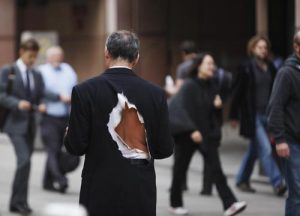
Half of all adults aged 18-35 now experience back pain. The cost to society is around £12.3 billion a year. As Acting CEO of BackCare I fronted new research for the ‘Can You Feel My Pain?‘ campaign linking it to the ‘sit still’ culture in our schools and offices. This is what the Daily Telegraph made of it:
‘Back pain ‘timebomb’ in store due to ‘sit still’ culture’ by Stephen Adams.
A “sit still” culture in schools and the workplace is leading to a “healthcare timebomb” of back pain in young people, a charity warns today.
Half of 18-to-34-year-olds now regularly suffer from back pain, found a survey of almost 2,400 people across Britain.
A quarter of young men with back pain said it affected their ability to work.
Overall, almost two-thirds of adults – all those over 18 – said they suffered from back pain, according to the online survey, carried out on behalf of Pfizer.
Sean McDougall, chief executive of the charity BackCare, which is involved with the drugs firm in a campaign to raise awareness of chronic back pain, said: “This survey backs up what our members are telling us about the difficulty in obtaining timely and adequate treatment for all types of back pain.
“But the real shock is the increase in incidence of back pain in young people.
“The ‘sit still’ culture of schools and the workplace, combined with lack of exercise, is creating a healthcare timebomb.”
Studies show that lack of movement in one’s daily routine leads to loss of muscle tone, particular in the lower back, which reduces the stability of the spine and can lead to back pain.
Mr McDougall warned: “Consequently, millions of people aged 18 to 34 are destined to spend the next 60 years living with back pain”.
Half of all adults with back pain (52 per cent) said they lacked the physical ability to perform daily tasks; while 45 per cent said it put them in a poor mood; and nine per cent said it had a negative impact on their sex lives.
The Can You Feel My Pain campaign is highlighting the incidence of neuropathic pain, that caused by damage to nerve endings, which has been estimated to contribute towards a third of chronic back pain cases.
Dr Ollie Hart, a Sheffield GP with a special interest in chronic pain, said: “Back pain is often treated as a routine condition by GPs, despite the fact that it can lead to many repeat visits and unresolved complications for patients.
“Neuropathic back pain is typically under-diagnosed but healthcare professionals can use simple checks including asking their patients some key questions about the specific types of pain they are experiencing, to help them quickly identify neuropathic back pain and ensure that they are prescribing the most effective treatments.
“The sorts of things they should be looking for are descriptions of freezing, shocking, crawling or burning pain.”
What next?
Sign the ‘Can You Feel My Pain?’ Bill of Rights
Find out why back pain is also affecting more and more children
Read the original text of this article: https://www.telegraph.co.uk/health/8759632/Back-pain-timebomb-in-store-due-to-sit-still-culture.html